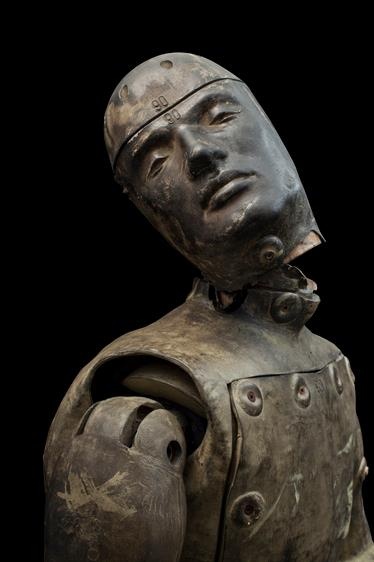
World War 2 parachute crash dummy
Here is a story that is not uncommon these days.
http://www.adistinctiveworld.net/health-department-raids-community-picnic-and-destroys-all-food-with-bleach/
And this curious bit of legislation: http://www.bloomberg.com/news/2013-04-09/kansas-s-self-destruct-button-a-bill-to-outlaw-sustainability.html
These are examples of an ascension of irrationality in state agencies, and a new level of aggression. That is the key, the aggression is coming out of a culture now inundated with representations of violence. The violence is eroticized and in a sense more aestheticized than ever. The mainstream studio and network product, and even back to dime novels, always told stories targeting teenage boys (which demographic has today slid north to men in their late twenties) with tales of daring and heroism. Today however, there is an additional sadism attached. And more graphic representations.
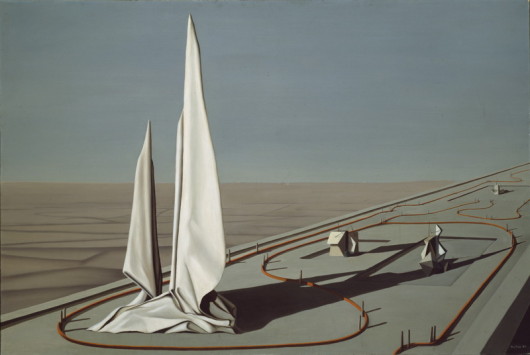
Kay Sage
How much has media and film created models for behavior and even more, thinking and the creating of policy? The tough guy cop who functions outside the rules is such an utterly exhausted cliche at this point that it is almost the norm for network TV. So when these white men in suits sit in their offices on Capitol Hill, fresh from three martini lunches, or quick blow jobs at the, literally, almost countless brothels in D.C., are they not adopting a sort of “what would Clint Eastwood do” mindset? There are unlimited reports almost about the bullying of interns, men and women, by congressmen, and congresswomen. The most famous probably being John Bolton, the man with the most unwholesome mustache in America. Bolton was known for browbeating underlings. It is often far more subtle than this, however. The white man in a suit embraces profit as a sign of toughness. None of that sissy sustainability for him, none of that vegetarian tree hugger nonsense for him. I could probably make a list of signifiers for masculinity, codes for toughness and power and dominance.
It’s black coffee, straight shots of bourbon or whiskey or best of all scotch, rarely mixed drinks, meat, cooked rare, (and increasingly a sign of hip is to know the best “ethnic” {sic} street food sites) and also anti intellectualism on all fronts. Reading a book is simply a sign of weakness, and worse. It is a sign of some sort of contagious mental sickness. Appreciation of automobiles, ability to work on said automobiles, belief in American traditional values, love of sports (especially football and baseball) and a respect for the military. Respect of all uniforms. Alcoholism is accepted, and treatment for it is even accepted, but so called hard drugs are still a sign of degenercy. Gambling is ok if you win. Gambling is better if you cheat. In fact cheating is not a problem at all, it’s a sign of cunning. And cunning is very very good, very masculine. Obviously fighting is great. Shooting too. An ability to cook well is acceptable to a degree, but it is also, when taken too far, a sign of moral decay and decadence (hamburgers, taco trucks, etc, again are clear signs of being an insider, in the know, which also again connects to cheating, which is ok, if you win at it). See, winning is EVERYTHING.
The anxiety of white men can be tracked in Hollywood film, of course, because white men write 98% of it. A few white women write. And such is the influence today of popular culture, especially TV and film, that politicians — an already despised class of weak white male — are more and more embracing a self image handed them by Hollywood tough guys. But lets be clear, policians are ok if they win. The President is always a tough man in movies. Why? Because he won. Displays of compassion are fine, but you will not find them unless they are bookended by acts of violence. Too much unmediated compassion is a sign of whimpiness.
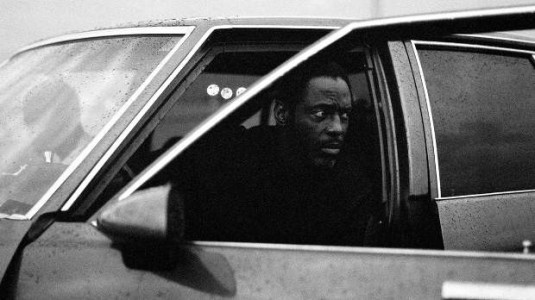
Blue Caprice, Dr. Alexandre Moors, 2013
Male figures of respect often have “pasts” for which they are in theory meant to atone. Of course the real message is, a dark past, especially a violent one is actually a sign of masculinity and sexiness (movie producers don’t have pasts). There is an interesting disconnect at the heart of this, though. The dark past is usually one connected to the military or police. Sometimes to crime, but not often. What you never see is a past of radical political action. Going to jail for murder is ok, going to jail for subversive politics is not. That is moral sickness. But here we see the unconsious longing of those white guys who write TV shows. I’ve never met an actor or writer (and its even more acute in writers and producers in fact) who didn’t feel on some level that he was inferior in terms of masculinity. Actors (much much less in the UK, where actors actually work in theatre and that rather changes this dynamnic) often try to do “authentic” things when they aren’t starring in movies. They go on safaris, or to Alaska hunting bears, or they fly planes to disaster areas, or learn martial arts, or they get drunk and get in fights. Something, anything, that provides the feeling of being a real man. Writers do the same, but producers are the worst. The white men in charge of media in the US are openly terrified, visibly palpably terrified of their own feelings of weakness. No new car, no new watch or shoes, no prestige seating at trendy restaurants can make up for this. So it makes perfect sense that these anxieties make their way into the movies they create.
Now, politicians and Wall Street bankers suffer these feelings of impotence, too. Its on record that Wall Street brokers are the heaviest users that exist of high end call girls. Up market escort services would go bust without movies producers and Wall Street bankers and stock market brokers. Power does not neutralize insecurity. And while a new generation of interns, for example, have arrived in Washington, I’m not sure their apparent diversity wont be swallowed up and digested by the machine.
The media however (run by the same white men) will stigmatize a black athlete for having six children with six different mothers. They do not ever mention the industrial level use of escort services for themselves and other white guys. The arrow of moral indignation always points at those who are black, brown, or poor. That Larry Summers is a known escort service junkie is not an issue. But if a basketball player has a too many kids, he is asked to atone somehow. Same of course with drug use. The U.S. prison system is overflowing with black men convicted of non violent drug offenses. There is not a single Wall Street broker in jail for cocaine use, when in fact they are among the single biggest demographic for cocaine purchases.
Sexual anxiety floods the world of white masculinty. It is not at all difficult to track popular culture in terms of sexual paranoia. What is football if not sexual anxiety?
What drives these new assaults on innocent citizens, often just sitting at home? It is clearly a confluence of factors; starting with a growing surplus population. There are no jobs. There is rising poverty. There are food shortages and now, legislation to further strip away the safety net. Private prisons means there is an economic demand for prisoners. The state is already normalizing the idea of SWAT teams answering the simplest of calls. The scenario of SWAT teams kicking in doors has been made into an iconic meme by TV and film. Any ten year old knows the drill. They’ve seen it a thousand times on TV. Daily life includes aggressive state policing of ordinary citizens. There is a generation now (and maybe its even the second, or even third) that is growing up watching hours of TV each day, or surfing social media and the internet, and watching depictions of state violence. Schools teach nothing. There is no hope for most adolescents that doing the prescribed thing, going to college, and graduating will yeild the possibility of advancement. They know what they are likley to get is debt and little more. Add to this the reality of state surveillance. There is nowhere to hide. All behavior outside a narrow normal is going to be red flagged. Those kevlar vest wearing commandos can come kick in your door. They can come destroy your picnic, they come fatally shoot your 96 year old grandfather with a taser and “non lethal” rounds. Everyone is watched all the time. There is a natural accomodation to the normative. If is fueled by fear if nothing else.
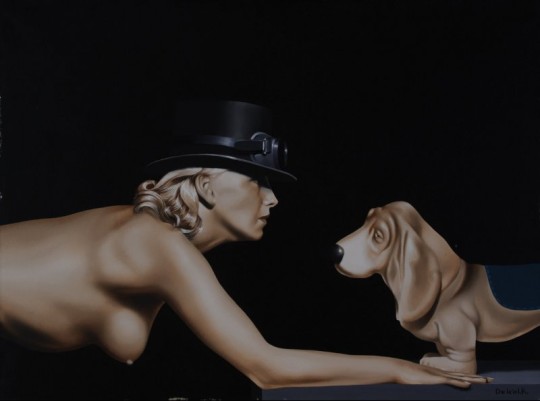
Roland Decol
So where is the line between mythic figures of resistance, and new protagonists of white anxiety? If Jesse James becomes a folk legend in the singularly young United States, how is that different than a character such as Jack Bauer? Well, the obvious first answer is that Bauer works for the Man. But lets take a better example, perhaps, and use Nucky Thompson in Boardwalk Empire. Or any character played by Dwyane Johnson or Stallone. There is no single quick answer, actually. Take Tony Soprano, in what way is this different? There is an interesting context created in all popular culture, today. Soprano is designated as outside the mainstream. He is goombah, a cartoon sort of Jersey mob guy. Now the fact is, the Jersey families were what was left after the dismantling of the New York families. But the point is more to do with a clear artifical world. There is no ‘real’ Tony Soprano. Are there folk heros today from the actual population? Ones that might so become? (Edward Snowden might, so its not surprising his manhood was repeatedly questioned by mainstream pundits). The second issue is Jesse James wasn’t on television. Not the real one. History, the past, is an editing mechanism. Nucky Thompson was real, but that was in the 1920s. There is in American culture a deep appeal for the outlaw. The mythology of the United States is full of outlaw figures, real and imagined. Today, the outlaw figure is much mediated. Today the mediation takes the form of this artifical “real” the studios and networks provide. The world is not the one shown on Bluebloods or any cop franchise. The poor areas of New York or Los Angeles, or Houston, or St Louis are places in which the police exercise extra-legal power, they dominate and harass, and abuse the poor. Especially the youth. It is a systematic and systemic domination that is carried out on every level possible. It is also, of course, deeply racist. I cannot think of a single show in which the police are depicted as institutionally racist and abusive. Not one that is even close. The corporate media creates figures of authority and sexual potency that enforce the values of the state. They are violent, and they are hyper masculine. And their masculinity is signified by all the things listed above, but above all else by violence. By a capacity for violence, and aggression. This is a culture that identifies with aggression.
One relevant point here is that popularity has come to mean commercial success. Commercial success means economic value for those who produced the product. This popularity leads directly to very authoritarian and anti democratic direction. The populace equates cash return with what they desire. If its popular I had better go see it.
Now, the evolution of popular art, in relationship to high “Art” is worth noting. The focus since the 18th century inclined, increasingly, toward high Art. This was the legacy of Hegel, mostly. The important thing, though, is that there arose an elitist set of principles having to do with the autonomy of the work of art. These principles (such as disinterested contemplation ) simply don’t work when discussing certain popular forms of creation. That aside, even, the fact was that all art, as Adorno (and others) saw it, was in the service of projecting something utopian. This meant by creating an elsewhere, something that implicitly critiqued what ‘was’. Something that had social awareness and also positied by its nature a criticism of the status quo. This could be formal, or structural, or in content even. The issue here is that while post modernism has assaulted the idea of the subject, this is not really the problem. The problem lies more in the fact that commodity culture, the mass corporate manufacturing of popular art, has mystified the idea of the real. The artwork, the narrative, ostensibly arises from a real social fabric, and interacts and addresses it’s own creation, and points toward another reality (Utopian). Except that popular art now rests in the hands of a very few, a hegemonic system that manuractures a false ‘real’. There can be no, and IS no, subtext or symbol that isn’t already neutralized by the terms of its creation.

White Man
In a sense, this is why Jameson’s ideas about symbolism are quite cogent right now. Under a system of such aesthetic domination, the artwork can only serve to awaken a sense of the aesthetic as a connecting channel to the subject and to the collective, as well as, by extension, the future. This false fantasy “real” of today’s popular culture is meant to close off the future. It is also meant to enclose the discourse about culture. And it does so with remarkable efficiency. Jameson’s critique of post modern art as, essentially a sub-contracted form of consumer capitalism, still feels right. This is probably too complex a topic to get into in any depth right here, but I think it’s safe to say that the commodity form, and reification, have now invaded and enclosed the consciousness of today’s citizen of the West. And the result has been that oppositional works of art are increasingly difficult not just to create, but for an audience to experience. I believe, on the one hand, that Adorno was right in his defense of modernism (against Lukacs’ idea of realism) and in the struggle to de-commodify that is the investment of a genuine avante garde. It is probably not an accident that even these terms are intentionally derided by institutional authority today. Turn to most leftist journals and they read like fan magazines or Cosmo. The artwork is meant to dream a future, in some sense, and it is in the form, the depth of form, that autonomous works are able to survive. The apologetics for post modernism, most of which seems only in the service of defending the Capitalist structure (by either ignoring it, or imitating it) ring in the ears like the repetitive staccato of TV commericals.

Jesse James
The artwork, the reason people create art at all, is, it seems to me, about two things: one is to fill in the missed encounter of our own personal history, our psychic formation, as well as to illucidate the missed history of our society, or perhaps the missed histories of everyone. To give voice to what was silenced. And two, through the engagement with it, the experience of it, to see an prophetic glimpse of something beyond the yoke of state mandated reality.
The long debate about the hidden readings of ancient texts, actually touches on this, too. The hidden meaning is as much a question of form as of content. The text is seen to be almost creating levels of meaning. That is the secret knowledge in a sense, the multiple meanings. That text can contain hidden alternative meanings. Now, for advanced capital, the project is (and increasingly so) the erasure of multiple meanings. It is the one dimensional meaning. Or non meaning. Instrumental thought. So, back to this one non-meaning, the corporate hegeomic ‘real’ that is presented hours each day on twenty channels, or in every institutional and University stage. The creation of ‘myth’, is now just the creation of celebrity. Mainstream papers spend inches of front page space instructing readers how to feel. The Huffington Post is particularly open about this. “You Will Be Charmed by Beyonce New Baby”. Celebrity myth. James Franco, Jay Z., Ben Affleck, etc etc etc. YOU WILL NOT BELEIVE WHAT CHRISTINA AGUILERA WORE TO THE BEACH!
You will obey. There is no meaning. Obama is angry….so says CNN. What is he angry about? No matter, he’s angry. Just like Dad.

Franco Mondini Ruiz
As an afterthought on the white male system. There is a tendency to over-simplfy the meaning of these observations. There is nothing worse than the petit bourgeois condescension to the working class under cover of identity politics by a new affluent University elite. And in fact, increasingly I find better off young black and gay youth refuse to examine the very abuses that formally had to be fought against so hard by earlier generations. The affluent gay white student, or black middle class student, or middle class white feminist will often dismiss the community of various groups with snide University patented terminology. They often have as little grasp what killed Kimani Grey, or any other state abuse, than the richest white kids. The comfortable leftism of journals like In These Times, or Jacobin, or the self congratulatory aires of quite a few others, all suggest a perfect contentment with things just as they are. The working class cannot justifiably be critiqued in any personalized manner because in this landscape, they are barely surviving.
The enemy is never the working class or underclass, no matter their pathologies, for those pathologies were beat into them. They bear the marks both mental and physical.
The new leftism of most of these publications (or the most celebrated and *popular* intellectuals) are astoundingly lacking in self criticism. They are fanzines, mostly, and here is an all too representative example: http://inthesetimes.com/duly-noted/entry/13845/is_breaking_bad_racist/
The message is, do not get in the way of my enjoyment of my favorite commodities.
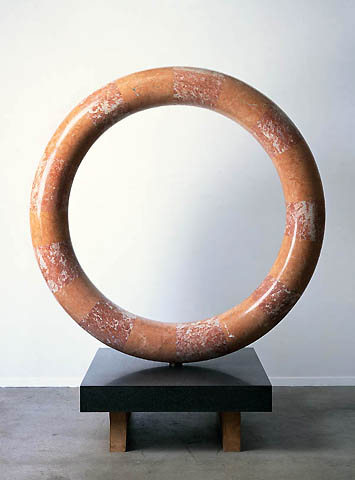
Isamu Noguchi
One of the best films of the last several years is Alexandre Moors Blue Caprice, which came out just this week in most of the U.S. The story of the two D.C. snipers is one of the few films made in the U.S. that creates a different ‘real’. In fact it is the spiritual sickness that comes from poverty and abuse and hopelessness that forms the main theme, coupled to the state instruction about violence, the state manufactured ‘real’, all merge in the moral bankruptcy of two men, one older and one younger, whose anger can find no rational expression. The distrubing malaise that lies just below the surface of the Empire is the actual topic of this film. The boredom, the inability to express or identify feelings, the confusions of many in the surplus population denied access to basic needs. When the only reading material is a sniper’s manual from the military. Love is abuse. Abuse is love. It is a startling film for all the things NOT in it. When someone called Breaking Bad like Dostoyevksy, I thought well, hardly. But Blue Caprice is in a sense very Dostoyevskian. And part of the tragic here is that there is actually so little story to tell. Crime and Punishment in 93 minutes.
It would be an interesting double bill with Hurt Locker. For in a way, Moors’ film is also about the military. There is no heroism, there is no white real. There is the dark psychosis of life without promise. There are echos of everyone from Genet to Fassbinder, to some of Pinter even.
Instrumental thinking is perfect for Capitalism. http://www.salon.com/2013/09/21/thats_not_autism_its_simply_a_brainy_introverted_boy/singleton/
Profit means people do not matter. Another trope for manhood is being “realistic”. Dreamers are weak. Dreamers might even be dangerous. No nonsense works seemlessly with anti intellectualism. Tough love. Tough love means mean spirited. Realistic means conformist. The acute sensitivity needed to deal with sensitive children, with children who might be gifted or might be, in fact, troubled (and yes, lets define that) is seen as being soft. Now of course there are wonderful psychiatrists out there, there are wonderful everything out there, but in ever fewer numbers. The real world more and more resembles a movie or TV show. People more and more perform a role they think is wanted. Wanted by whom? Well, by authority. By who is watching the feeds from all those CCTV cameras. By their boss, if they are lucky enough to have a job.
In today’s United States, the police operate with impunity. http://dissenter.firedoglake.com/2013/09/21/cuny-union-condemns-police-repression-at-petraeus-protests-cuny-responds/

Glow in the Dark shrine to the Virgin.
It’s the movies. As a footnote to conclude with, on the subject of the erasure of meaning, Danny Boyle’s latest film is out, Trance. I would try to tell you what it was about, except it’s not about anything. Vinncent Cassell and Rosario Dawson are in it. The sort of backdrop to the story is an elite London auction house, selling a rare Goya. There is a lot of blue screen, and saturated color (for no reason I could see) and Rosario Dawson looks good without her clothes on, and Cassell is always sort of vaguely interesting, although he looks pretty embarrassed here. And James McElvoy is his usual irritating presence. Literally, there is no subject to the film. There is only a hint of a story. And that hint makes no sense. But who cares, it has rich apartments, Mercedes Benz and Saville Row suits. Oh and a bunch of pointless violence. People die. Yawn. Oh, a Goya, yawn…god, excuse me. Didnt sleep well. And there is a hypnotist.
Boyle is the poster boy for empty. And for reactionary. For his films are always reactionary.
Trance depicts no real world. It posits nothing Utopian because there is no narrative in which to engage. It is a fashion layout. It is violence and nudity. And in the background some “famous” paintings. I remember I laughed when I first saw Sam Fuller’s Naked Kiss. I love Fuller, mind you (up to a point) but an intellectual he was not. And so when “classical” music was needed, he chose Moonlight Sonata. Boyle does the same thing, really. The names of the “famous” painters are just the names you might glean from Cliff Notes. Or wikipedia under ‘Famous Artists of the World’. There is an inability to reach a level of sophistication that is other times would be deemed just basic. The Irish Catholic alter boy by way of the BBC and Royal Shakes company remains only opportunistic. Boyle is, in the end, nothing except shallow. Zombie films, his destruction of a perfectly good pulp novel (The Beach) and then the heinous Slumdog Millionaire. Oh, and the Olympics opening ceremony. Very popular, that. The resume of a hack, pandering to a class that can reward him.
The moral gravitas and beauty of Blue Caprice is of another realm, almost. Still, it is heartening to see a film like Blue Caprice, for it so defies expectations. That the subject matter is two real life serial killers is more astounding, really. For there is not the slightest hint of sensationalism, nor sentimentality. Moors has embraced the story as if it were Biblical. The older man, an Ahab figure (again) who has no Whale. He is an Ahab with delusions of being Job. In Blue Caprice, guns kill people. They cause pain, they rip apart lives. They are treated as the extension of the pathology of a society that treats people as fungible cogs. But Moors respects the suffering of these men, and certainly respects the pain of those they hurt. Their anger is frightening, because it is magesterial, in the way Dostoyevsky is. One does not know what to do with it. A late scene ends with the lawyer who speaks to the younger Lee Boyd Malvo, watching him led back to his cell. She puts her hands to her face. Not to cry, not in frustration, but in a recognition of the impossibility of knowing certain things. The impossibility of tragedy.


Another great article! You mention the absolute street authority of our militarized police in poor, urban America, but it is less than the authority of our Prison System to dispense sentences of anal rape and even death. The death sentence of Ariel Castro inside prison to cover a decade of shoddy Cleveland Police work has been bothering me, especially the breezy dispatch of the MSM to this story.
Keep up the good work.
Thanks for the post. Where would you point us to read more of Jameson’s commentary?
George, the main piece, relevant to this is, The Political Unconscious……..
Jameson’sPostmodernism aged well too tho hmore recent stuff on Utopia is this same fan discourse as the postpostmod gen issues. Anyway this is my favourite post so dar. This winner worship…the crudest social Darwinism that really does just validate success/power…we see now how these shows like sopranos and 24 are helping or intended to help ppl accept things that in former justificatory schemes of empire would cause discomfort…like the US ruling class advertising its partnership with “all Qaeda”. We would like that tony soprano might one minute partner with bad ass turrist Islamix for profit and the next minute shop them to someone for torture as evildoers just to steal their capital assets. Because profit/power is all that is holy. No longer any need to justify capitalism or really this post cap it list proprietor speciss supremacism with reference to anything like the commonweal or even xtian virtue
Boyle is this film industry solipsist – everythingh is just about making movies dressed up as something else. The one about voyage to the sun – we’re losing the light! hurry! – had that “one costly shot at eternal stardom!” feeling even beyond the grand pun. The space ship looked like a studio…with trailer, screening room, editing room etc. The space travellers just did things people do while working on movies, behaving like movie people. The hideous eliminationist autism of this solipsism was most striking when they did this:
http://www.examiner.com/article/slumdog-millionaire-child-actors-having-trouble-readjusting-to-their-normal-lives
http://www.thenational.ae/news/world/south-asia/slumdog-millionaire-child-stars-still-living-in-squalor
Of course to a point everyone in the wealthy world with access to social wealth concentrated in the core exploits the immiserated majority including these kids, but Boyle deliberately consciously used his inherited power to inflict torment in the production of his self-celebration and a mythology exculpating him and honoring him as a magnanimous benefactor of the propertyless in bidonvilles worldover.
@molly…
yes, not that you mention it, Trance is really another movies about making movies. Id not thought about that, but it explains all the bluescreen and apartments that resemble studio interiors. Thats very accurate. Amazing the more I think on it.
His failure of imagination is most obvious in that spaceship to the sun film…….where the final destination is just out of focus…the mysterious stranger is out of focus. When in doubt, make it blurry.